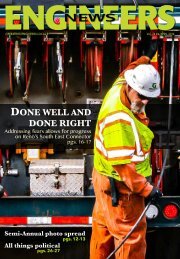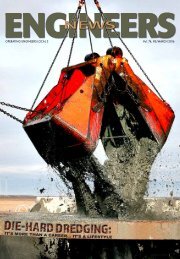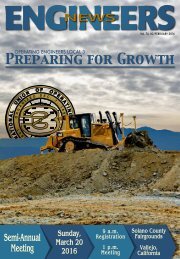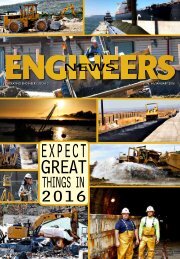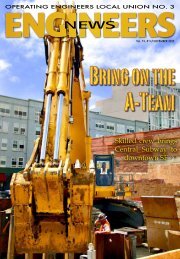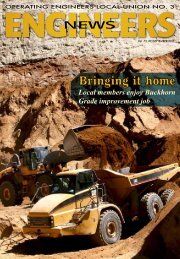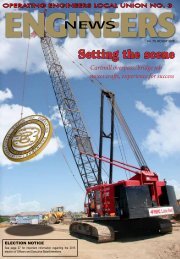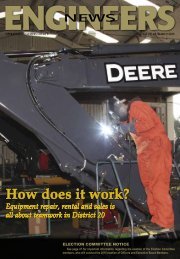Engineers News - October 2015
October’s edition offers many important updates, including the details of the new Master Agreement for Testing and Inspection, the Retiree Association Meetings schedule and some upcoming trainings in Utah District 12. You can also read all about how our members are faring as the fires rage on in Northern California. We have also included a Semi-Annual photo spread (more of these photos are available here), as well as the usual work-picture coverage in our District Reports.
October’s edition offers many important updates, including the details of the new Master Agreement for Testing and Inspection, the Retiree Association Meetings schedule and some upcoming trainings in Utah District 12. You can also read all about how our members are faring as the fires rage on in Northern California. We have also included a Semi-Annual photo spread (more of these photos are available here), as well as the usual work-picture coverage in our District Reports.
- No tags were found...
You also want an ePaper? Increase the reach of your titles
YUMPU automatically turns print PDFs into web optimized ePapers that Google loves.
Tech <strong>News</strong><br />
Testing and Inspection Master<br />
Agreement ratified<br />
By Michael Strunk, senior business representative<br />
It was a long, hot summer for the Technical <strong>Engineers</strong>, but<br />
we are pleased to announce a new three-year Master Agreement<br />
for Testing and Inspection. The new agreement was ratified on<br />
July 25 and is retroactive to July 1. The new deal took more than<br />
a dozen meetings with the Council of <strong>Engineers</strong> and Laboratory<br />
Employers, Inc. (CELE) and five special-called meetings with the<br />
Testing and Inspection membership. Those meetings included<br />
a strike authorization vote followed by a first-ever Technical<br />
<strong>Engineers</strong> Fair Industry Strike Training (FIST), where 95 percent<br />
of the members present told the bargaining committee to go<br />
back and try for more or they were headed to the sidewalk, if<br />
needed, to get a fair agreement.<br />
In the end, 697 ballots were cast, and in the closest balloting<br />
in the Technical <strong>Engineers</strong>’ 61-year history, we got a deal<br />
the assembled membership could live with. The three-year<br />
agreement will put $6.25 into the package over the lifetime of the<br />
agreement, including 65 cents earmarked for apprenticeship and<br />
journey-level-upgrade training. That 65 cents will maximize the<br />
recent recognition of the Apprenticeship Program as a provider<br />
of continuing educational units for the International Code<br />
Council. These classes will take some time to fully develop, so<br />
stay tuned for more information here and on the Local 3 website<br />
at www.oe3.org.<br />
While it may seem like it is always about the money, these<br />
negotiations were different in that they focused on how we<br />
can continue to expand in the recovering but still somewhat<br />
tentative economic conditions beyond the Bay Area, which<br />
went back to work in 2012-2013. The owners wanted to peel<br />
laboratory technicians and laboratory supervisors away from<br />
the bargaining unit, and the membership overwhelmingly<br />
and resoundingly said no. The owners wanted a lower wage<br />
package outside the nine Bay Area counties as well, but again<br />
the membership said NO.<br />
As a compromise, the membership did agree to a modification<br />
of the agreement outside the nine Bay Area counties that allows<br />
for pay per classifications, with pay being calculated by the<br />
highest rate of the day. Those calculations are per project, not<br />
to exceed two rates per day, with a two-hour minimum pay per<br />
group and an end to the old practice of requiring Group 2 to pay<br />
for all work performed regardless of classification once Group 2<br />
status was obtained. While some see this as a step back, others<br />
see it as an opportunity to perform work they couldn’t before.<br />
Only time will tell, but it is how all other crafts operate, and it<br />
does make us more competitive against the non-union.<br />
Not only were laboratory workers kept in the agreement,<br />
but their presence was expanded, and in the process, two<br />
new classifications were added to the Collective Bargaining<br />
Agreement (CBA). This will make it easier to bring new members<br />
into the industry. Groups 5 and 6 will work alongside Groups 1<br />
to 4, which were established in 2008. These groups serve as the<br />
basis of our prevailing wage determinations for the 46 Northern<br />
California counties for Material Testing and Inspection work, as<br />
well as the basis of the agreement, which covers Hawaii, Utah<br />
and Northern Nevada.<br />
Some of the provisions of the agreement are that the word<br />
“radius” comes out of the travel time and the subsistence<br />
premium increases from $25 to $30 per day in excess of 100 miles<br />
driven from the employee’s residence or $85 per day in excess of<br />
150 miles. A new per diem rate of $120 will also begin in July of<br />
next year. Other provisions include enhancements to travel time<br />
for standby and night shift. This will allow for “disruptive shift<br />
pay,” which provides a minimum of eight hours of night-shift<br />
pay when the shift precludes the employee from working the<br />
following day, excluding weekends and holidays.<br />
For a complete list of the changes, visit the Members Only<br />
section of the Local 3 website, where members can also find a<br />
copy of the entire <strong>2015</strong>-2018 Master Agreement for Testing and<br />
Inspection.<br />
UNit 12<br />
Knowledgeable crew keeps<br />
fleet running<br />
By Larry Southerland, business representative<br />
Members at San Jose Equipment Sub-Shop No. 24410 repair<br />
and maintain a fleet of Caltrans’ equipment, which includes<br />
solar-powered arrow boards, cars, pickups, trucks, loaders,<br />
mowers and graders. The equipment in this fleet comes from<br />
a variety of manufacturers and requires a very knowledgeable<br />
crew of technicians. They must keep up with ever-changing<br />
technology to improve fuel economy and address carbon<br />
reduction. We thank them for their invaluable skillset that<br />
keeps the equipment on the cutting-edge and their drivers safe.<br />
Leadworker Bradley Ersepke.<br />
Top row, from left: Heavy Equipment Mechanic (HEM) Robert Coyle, Highway<br />
Mechanic Supervisor Randy Lewis, HEM Thomas Copeland and Equipment<br />
Material Specialist Ron Boisseranc. Bottom row, from left: HEM Michael Smith,<br />
Cupertino Field Mechanic Jorge Olivares and Fremont Field Mechanic Alberto J.<br />
Pena.<br />
<strong>October</strong> <strong>2015</strong> | 13




